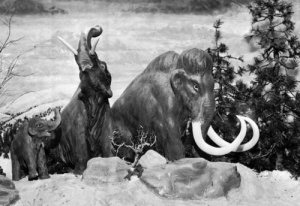
SKELETON OF PRE-HISTORIC MONSTER IS FOUND NEAR LONGHORN MOUNTAIN
A mammoth pre-historic monster wandered over what is now Kiowa County. He was a gigantic animal of bone and muscle, tall, broad and powerful. No animal in existence today is comparable to this massive being. The sight of such a monster today would strike fear into the hearts of all who beheld it.
The big animal made its way to Longhorn Mountain, south of Mountain View. The mountain at that time presented a far different appearance from that of today. It was more rugged, larger, and more like the Rocky Mountains as we know them.
The monster was in search of water so he went in the direction of a large river which flowed through that district at that time. He was especially thirsty, and in his hurry to reach the water was not careful of the ground over which he was passing.
He struck a little wet sand, but paid not attention to it and went on. He had gone but a short distance until he began to sink slowly, and as he noticed this he attempted to hurry on to pass the soft place.
He mired down, however, and could go no further. His massive body, tons in weight, bore down on his feet and forced them down into the sand, half mixed with water—quicksand.
The animal floundered and fought to preserve himself. Huge quantities of water and sand were thrown high into the air as the animal struggled. The great bulk of his body would rise out of the sand only to flounder down deeper into the sand and water as it came down.
The more the monster fought to preserve him, the more he sank. The quicksand gradually pulled him down. As the huge animal saw that he was doomed, he let forth loud shrieks and bellows, and struggled even harder.
Every struggle of his immense body, however, only served to speed the time when his massive head should be brought under the quicksand and his breathing stopped. This came in a short time. Air was cut off from his lungs as his head was drawn under the surface. He held his breath as long as he could. His lungs burned. Then he tried to breathe, and as he did so, large amounts of sand and water were sucked into his lungs. Hit great body trembled, and a few seconds later a great convulsion marked his death. His body sank a few feet further into the sand.
Long years passed. The earth under went changes, man came into existence on this continent and settlements were begun. Then people began to come west and settlements were made in Oklahoma.
When excavations were being made to enlarge
a spring on Carl Ried's
farm at the southwest corner of Long-horn Mountain, the bones of this
great animal were found.
The teeth are in a good state of preservation,
and are as large as
a man's head. Other huge bones also were found, including a round,
flat bone as large as a dinner plate, thought to have been a knee
cap.
Mr. Reid was enlarging the spring to form a
water supply for his new
home and a swimming pool which he plans to build. As soon as the
bones were discovered, however, he ordered the work stopped and
telegraphed to Washington for information concerning them.
The spring had been used by the .public for
drinking purposes for the
last twenty years, is actually being studied at the present time.
Undoubtedly the gigantic animal actually existed and must have roamed
this section of the universe.
The method by which he met his death may be
wholly imaginary, yet
the bones are located in a quicksand formation; which would indicate
that something similar to the foregoing must have taken place.
@@@@@@@@
This article was printed on page 6 of the Hobart Democrat-Chief, Tuesday, August 4, 1925. Longhorn Mountain is approximately 11 miles south of Mountain View to the west of Highway 115.